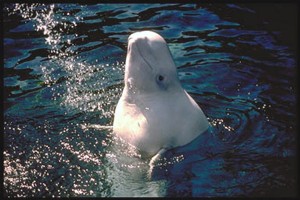As scientists attempt to better understand the endangered Cook Inlet beluga whale, they are taking a closer look at what the whales eat, but studying the dining habits of beluga whales is harder than you might think.
Sue Saupe is scientific director for the Cook Inlet Regional Citizens Advisory Council – or CIRCAC. She and other scientists have been working on a study of beluga whale prey since 2008, attempting to measure the levels of harmful pollutants in the food that ends up in the whale’s bodies.
Saupe says one pollutant is of particular concern when it comes to beluga whales – polynuclear aromatic hydrocarbons – or PAHs.

PAHs occur in deposits of oil, gas and coal and can be harmful in high concentrations. Saupe says PAHs are often more abundant in near-shore areas, where beluga whales tend to congregate. The data on PAHs in Cook Inlet is very limited, says Saupe, and the CIRCAC-funded beluga whale prey study is the first real attempt to measure them in whales.
The idea is to measure the pollutants in the prey that beluga whales eat. Saupe says that in the summertime, that’s not much of a problem. With funding from CIRCAC and the National Marine Fisheries Service, scientists conducted the first prey study in 2008 and 2009.
Saupe says the results of that study, along with tissue samples taken from the whales’ livers and blubber, did not show that PAH levels were affecting the beluga whale stock.
“We do not have that kind of information but concerns about PAH levels and concerns about beluga whale reproductive success warrant further study and likely mitigation,” Saupe said.
And so the focus turned to wintertime prey of beluga whales.
A winter beluga whale prey study was funded primarily by the Kenai Peninsula Borough and was supposed to begin in the fall of 2011.
Saupe says the study ran into problems right away, when a planned trawl survey in November had to be cancelled when ice clogged the upper inlet during a run of high winds and cold temperatures.
Trawl surveys were a bit more successful in the spring and fall of 2012 but even then, trawling in the northern inlet turned out to be a challenging and dangerous undertaking. Saupe says bad weather, quick-moving currents and a maze of well heads and pipelines on the ocean floor all made for tough going trying to trawl for sample fish.
“It’s extremely treacherous conditions and that’s why we can find no good resident fish for this area of Cook Inlet,” Saupe said.
As a result, the results of the wintertime beluga whale prey study are inconclusive, at best. Saupe says one thing the study shows is that perhaps the stock of potential prey in northern Cook Inlet is low and that beluga whales get most of their food from southern areas.
Scientists are looking over the results of the studies now and hope to have a completed report in the next couple of months but Saupe says that if your goal is to get a handle on the level of harmful pollutants in the food of Cook Inlet belugas, more study is going to have to be done.




